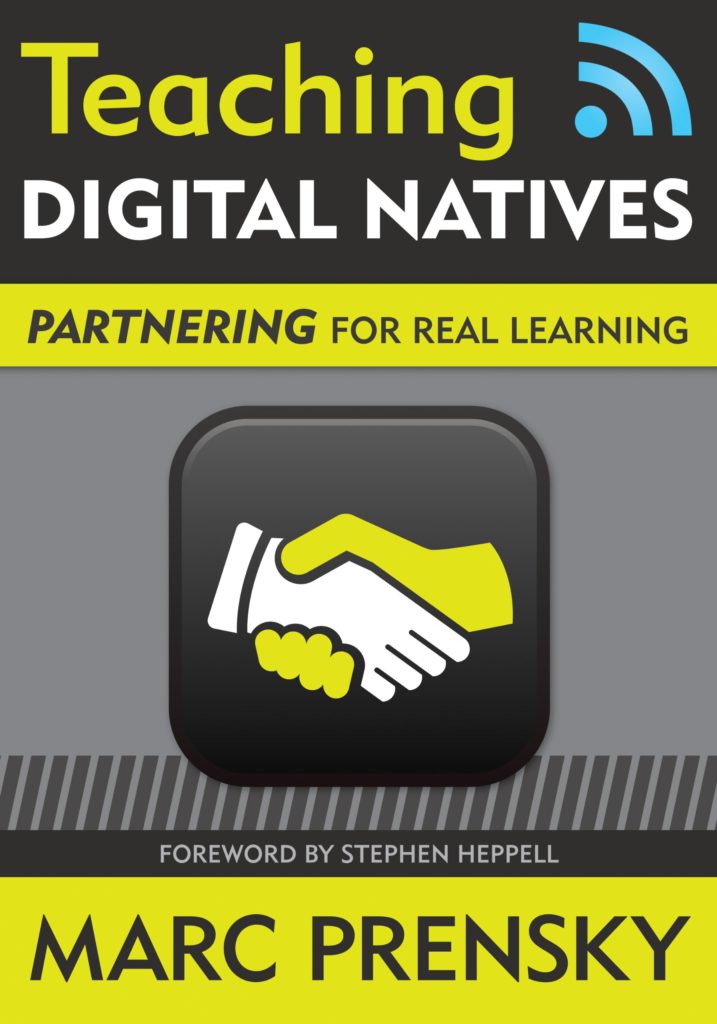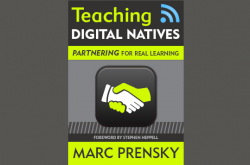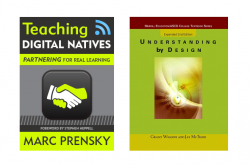
[Note: All links to this book are Amazon Affiliate links. If you click any of these and make a purchase from Amazon, we will receive a small commission at no extra cost to you. Thanks for your support!]
This is our second and last discussion of Marc Prensky’s book, Teaching Digital Natives: Partnering for Real Learning. To read more about the first half of the book and add your own insights to the conversation, see our post on Teaching Digital Natives, Chapters 1-5.
As with the first installment, I’ll just jot down a few notes about things I felt were relevant in each chapter, along with a comment or question for discussion. Please add your own thoughts in the comments below — especially if you’ve already tried this approach or are planning on giving it a shot soon!
Chapter 6: Using Technology in Partnering
In Chapter 2, Prensky introduced the noun/verb concept of partnering, where “verbs” are the skills students have practiced in school throughout history — interpreting, analyzing, presenting, measuring — and “nouns” are the tools they use to develop and demonstrate those skills. Long ago, the “nouns” were limited to pencils and paper. Now, as the nouns grow exponentially, we need to be diligent in keeping our instructional focus on the verbs, constantly ensuring that students still practice those same vital skills. This chapter goes into more depth about how exactly we should handle the nouns.
The advice is this: (1) Treat technology as an enabler, a tool for helping students learn the necessary content and skills better. (2) Be creative in solving access problems — pair up students to share technology, work with your school to improve before- and after-school access, and so on. (3) Let students use as much technology as they can get their hands on to reach curricular goals; do not limit them to the tools that you, the teacher, are comfortable and familiar with. (4) The teacher’s role is to make students aware of what’s available, ensure that students do high-quality work, and point out potential pitfalls. Our role is NOT to use the tech for them.
But we do have to know something. “It is important that partnering teachers know what tools exist, understand what each of the tools can do, and, to the extent that the tools are available in the school, make them available to students and encourage their use” (98). For me, this makes the expectations for teachers feel more realistic: No, we don’t have to be totally tech-savvy to allow our students to do good work with technology, and no, we should not use the tech for them, but we need to have a pretty solid understanding of what’s out there, what it’s capable of, and how students might use it. In other words, the teacher needs a good sense of the infrastructure of technology.
This might intimidate those who think the whole ball of wax is just too much to digest, but Chapter 7 offers a handy tool to help us. Before we go there, I have these questions: How does a teacher actually manage all this? What does a typical class period look like? What is the recordkeeping like? I’m definitely buying into the idea of partnering, but the logistics still baffle me.
Chapter 7: Understanding the Nouns, or Tools
This chapter is a simple directory of many of the technology tools — the “nouns” of partnering — that students can use to learn and demonstrate learning. Two features of this list make it especially useful.
First, although specific brand names appear on the list (there are separate entries for Kindle, Twitter, Skype, and so on), much of it is organized by type of technology, which allows the reader to understand the categories of tools. Reading through this chapter is a real education, and it helps give some order to the tech wilderness.
Second, for each noun listed, there is a list of verbs that align well with it. For example, the section on Facebook lists collaborating, planning, and behaving ethically among the verbs students can practice while using it. The section on Survey Creation Tools (like SurveyMonkey) lists verbs like analyzing, exploring, verifying, and experimenting.
This chapter just made me excited. It also made me feel more competent: Having all those terms explained so clearly makes all of it easier to understand and that much more doable. I guess my only question after reading this chapter is Where do you start?
Chapter 8: Let Your Students Create
Here we are encouraged to have our students create whenever possible. Instead of defining and limiting the end products of their learning, we are now empowered by technology to let students actually make the kinds of things they’ll find in the real world — websites and spreadsheets, videos and podcasts, simulations and video games.
When planning for this kind of creative work, we should allow for as much real-world creating as possible, giving students the opportunities to produce things that can be seen by a real-world audience. We should also have them participate in world conversations, interacting outside the school walls with experts and laypeople who care deeply about the content they’re working with. This interaction can be as easy as a message board or comment stream or as formalized as a Skype interview.
We are reminded to allow students to choose their own end products and to follow their passions whenever possible — especially the “slackers,” who are less likely to naturally engage in this kind of work.
Although the idea of this sounds wonderful, the kind of work lots of students would really enjoy, my questions come down to logistics. How does the teacher manage this? What does it look like on a day-to-day basis? What if some students finish their projects days ahead of other students? If students go in substantially different directions with their creations, how does a teacher grade student work with any consistency?
Chapter 9: Continuous Improvement Through Practice and Sharing
This is where we see the first of two “I” terms that are essential to partnering: iteration. Rather than treating each student project or performance in isolation, good partnering has us view successive products as iterations — “redos” or next attempts — of a set of skills. The goal is to keep improving on what you did the last time around.
As teachers, we are urged to also practice iteration in our own work, and to be transparent with students about this, to model this kind of attitude: “Let’s see how well I do at this the first time. Then, let’s see if I can do it a little better.” This will require a serious mind shift for both teachers and students, especially those who really just want you to tell them what to do and how to get a good grade.
Although this chapter is more theoretical than practical, I think it’s crucial for developing a partnering mindset. For any teacher to successfully embrace more technology in their teaching, they have to let go of the idea that things will work perfectly the first time around. And it’s crucial to pass this attitude on to students as well. At this point, my question is still along the same lines (and I can imagine it coming from students, too)…How does all of this translate into grades? If a student is encouraged to iterate, to make continuous improvements over time, does that mean grades at the end of a term are weighted more heavily than those at the beginning? Are we grading only for improvement? As much as I hate to focus on things like grades, I know they are a reality in schools for all parties: administrators, students and parents alike want a clear measurement of student progress, and so far I don’t see exactly how that’s accomplished in a partnering classroom.
Chapter 10: Assessment in the Partnering Pedagogy
Here we get the second of the two “I” words: ipsative. Although formative and summative assessments still have their place, the partnering teacher needs to employ a broader range of assessments to really help students grow. Within this broader range is ipsative assessment, where your performance is measured against your own personal best. Along with this, we should also use more peer assessment, self-assessment, and real-world assessment, the kind that comes after a student posts a video on YouTube, for example, and waits for the world to react.
We are also encouraged to assess students with the tools they already have at their disposal. So instead of giving them a test that requires them to memorize facts — the kind of knowledge that is most likely to wash away shortly after the test is over — we should expand the concept of open-book tests, allowing students to use devices like phones to find the information they need. If they can look it up in 30 seconds in real life, why shouldn’t they be able to do it for a test? I know this will bother some people, and I’m thinking two arguments are likely to come up: (1) There is value in the mental work required to memorize certain facts or concepts. And I agree with this. Students shouldn’t have to use calculators to do simple multiplication because they never learned their times tables. I think the take-away here is to allow open-device for the kinds of tasks where a device would be available and useful in real life. (2) What about cheating? Won’t students just text each other the answers? I’m thinking that if an assessment can be easily aced with the kinds of answers that can be texted, it’s probably not a very good assessment. With more questions that require higher order thinking, students can demonstrate what they know in a way that can’t easily be replicated via text.
This is all good stuff, and it lines up perfectly with the idea of a “scrapbook” of assessment in Understanding by Design. Still, by the end of the chapter I have the same questions about logistics. I really hope Prensky has plans for future work that addresses these questions, showing us case studies where we can see how a partnering classroom works on a practical level. If you are reading this and have already solved some of these practical concerns, please share them!
So how do you plan to use what you’ve learned from this book in your teaching? Because partnering is such a change from the way many teachers operate, the idea of completely overhauling your methods can be paralyzing. That’s why I would encourage you to take small steps, to take one unit and add more partnering to that, being transparent with students about what you’re trying. If and when you do, come back here and tell us how it went. Then, in the spirit of iteration, do it again. ♦
______________________
Check out the other book study we have going this summer: Wiggins and McTighe’s Understanding by Design.
Click here to read our summary of Teaching Digital Natives, Chapters 1-5.





My comments Prensky Chapters 6-10
I am still not understanding how teachers should know what is available today and tomorrow, but not know how to use them necessarily. In order to support the use of the right tools, then teachers should use them as well.
The idea that teachers who are especially fluent might be tempted to use technology for them…I have set up a blog, but students exchange comments amongst each other. I disagree with the statement that students use tools effectively. Students misuse technology even for school assignments. Overdoing text, poor color choices, cutting and pasting from the internet instead of synthesizing the information….etc. They need modeling and then coaching. Requesting revisions? When is this suggested?
Some of what Prensky says….mmm…I find a bit accusatory.
For some reason I made a notation that says a rubric that encompasses all the verbs and take into account all of the nouns needs to be created for use for students if we are giving choice with the tools to use.
With respect to real, world audience I wholeheartedly agree with this. Does Prensky suggest that the teacher seek out forums for this or is this also the onus of the students?
Rigor…Expectations….Use of Creativity
This is one of the biggest arguments in my school building.
“the kids can’t” or “they can’t handle” or “they are not ready for”
The message to the students with respect to teacher belief needs an overhaul…not a mere reframing/reshaping.
Allowing students to create their way….is this realistic preparation for students’ post-secondary endeavors…ie College? Career? Technical? Military?
Iteration is the hard part (at least consistent and timely iteration anyway)
Learning from Colleagues….the culture in the building has to be conducive to sharing.
I am going to deploy the rubrics for partnering for teachers and students as a google doc anonymously to see where I stand with my students. We will go into our 2nd semester in August and this will be a good time to gauge and identify weaknesses.
Hi Shayne,
Okay, here’s an example of a teacher knowing “of” a tool but not necessarily “how.” For me personally, Prezi would be one of these. I know exactly what Prezi is and what it can do (in general), and I have played around with it, but I am by no means comfortable enough that I’d be able to teach students how to use it. BUT, if I had a student who either knew how to use it or really wanted to try for a given assignment, I would let them. To the first kind of student, the one who already knows Prezi, I would say, “Learn how to do at least 3 things you don’t already know how to do, and be prepared to give our class a 10-minute lesson on Prezi basics before the semester is over.” To the second one, who wants to try it, I would say, “Go online and start looking for free Prezi tutorials. You can teach yourself how to use it. Also, _________ over there is great with Prezi — sit down with her and get a quick overview.” I don’t ever have to get my hands on it. I also don’t really have to know how things work “back stage” in Prezi. What I DO have to do is provide that student with a rubric for the assignment that outlines that the presentation must provide the information in a clear, organized way, must introduce viewers to the subject in a way that grabs their attention and makes their purpose clear, and must be designed in a way that is aesthetically pleasing — concepts we would study as a class for any and all “products.” Now here’s the thing: if I hadn’t ever seen or heard of Prezi, it’s my responsibility to obtain a basic familiarity with it, but I think that can be accomplished in 5 minutes, sitting with someone who knows the tool. They could basically say to me, “It’s kind of like PowerPoint, except you can move around the screen more
I’m curious to hear more about your thoughts on Prensky’s “accusatory” content. Can you give a few examples of those things?
Thank you again for your thoughtful participation and for the time you’ve put into both book studies.
Hi Shayne,
Okay, here’s my understanding of how knowing OF a tool without actually knowing HOW to use it can work: For me, something like Prezi would fall into this category. I know what Prezi is and have played around with it some, but if someone asked me to make a Prezi for tomorrow, I would have to set aside a LOT of time. I certainly couldn’t help out a student who was using it. But if one of my students wanted to make a Prezi for an assignment, I would say yes. If he already knew how to use Prezi, I would tell him, “Learn how to do three new things with it, document what you learned, and be prepared to give the class a 10-minute lesson on Prezi basics.” If he had never used it but wanted to try, I would say, “Get on YouTube and find some tutorials. Also, go talk to _________. She can give you a quick overview.” In either case, I don’t ever have to go near the Prezi environment. I don’t have to know what goes on “backstage” to create the final product. What I DO have to do is set expectations, to create a rubric that outlines that the product must grab the viewer’s attention right away and make its purpose clear, organize information clearly and logically, be aesthetically pleasing…all concepts we will study as a class all year long, regardless of the product. The verbs.
So what if I had never heard of Prezi, but my student still wanted to use it? It would take about five minutes for someone to sit me down, show me a Prezi, and say, “It’s kind of like PowerPoint, except that all your information is gathered within one large image, and you can move around with a lot more flexibility than you do with PowerPoint.” Got it. If no one could sit me down, I could look online to learn about it.
I agree that students use tools ineffectively – you’re absolutely right that they make a lot of bad choices, and I think these are things we can teach them, again without necessarily knowing all the specific how-tos. For example, we can give lessons in basic design principles: We can examine brochures, websites, magazine ads, even TV commercials and talk about font choices, white space, etc. We can give lessons on synthesizing research vs. plagiarizing. Both of those lessons are in the verbs. They don’t require us to know a single piece of technology well.
I would like to hear more about the “accusatory” content – can you give a few examples?
As for the real-world audience, I don’t recall whether Prensky put the onus on us or the students for finding these opportunities. It’s probably a little of both – we find some opportunities, then show students how to seek out more on their own. We have the benefit of life experience, of knowing “how the world works” in a broader sense than our students do. So while they might know of a local injustice that’s happening, we can help them understand that contacting members of local government is a way to effect change. Once they’ve tried that once, they should be able to transfer that knowledge to other situations.
I get your reservations on whether allowing students to create “their way” is realistic. I think this is a gray area that people could easily misinterpret and go too far in the direction of anything goes, which would NOT be good preparation for careers, etc. This is why it would really help to see high-quality case studies and examples of people who are already doing it. It would help everyone interested in partnering get a much clearer idea of where the line is between teacher expectations and student creativity.
Thanks again for your thoughtful participation with both book studies, Shayne. I sometimes think “if one person gets something out of this, it’s worth it,” and it turned out you were the one person! Your students and colleagues will really benefit from what you’ve learned this summer. Please come back and share more as you work to implement these concepts in your school this year.
Hi Jennifer, maybe accusatory was a bit strong. I do find my feathers ruffling when Prensky places the blame for bored students solely on the teacher. I would like to think that there are other contributory factors, but realize that I have control on how engaging my lessons are.
I hope you are having a good summer!
I hope you’re having a good summer too, Shayne!
I also wanted to add that I thought a good place to start students with the identifying their passions was the RoadTrip Nation site.
They also offer a “What’s Your Road?” self-guided experience. Students take a self-assessment and they are then linked to archived videos of people who pursued those same passions. I am going to use this as a baseline.
What a cool site! Thanks for sharing it, Shayne. Here’s the link: Roadtrip Nation